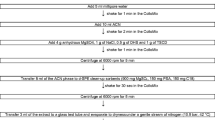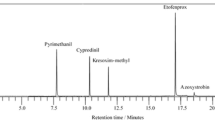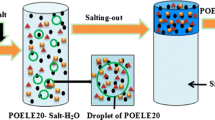Abstract
Contamination and carry-over of trace zearalenone (ZON) and its metabolite α-zearalanol (α-ZOL) from different feedstuffs to foods in different seasons were monitored by molecularly imprinted solid-phase extraction (MISPE) and high-performance liquid chromatography with fluorescence detector (HPLC-FLD) for the first time. Molecularly imprinted polymers (MIPs) bond ZON and α-ZOL selectively were prepared using cyclododecanyl-2,4-dihydroxybenzoate (CDHB) as the pseudo template. By using MIPs as sorbents of MISPE, selective enrichment of ZON and α-ZOL by MISPE increased the accuracy of HPLC-FLD. Seasonal differences on ZON contamination were observed in different feedstuffs and raw milk. But only the carry-over of ZON from cow feedstuffs to raw milk was observed. No α-ZOL contamination was detected. The humid and warm weather in April and July in Wuhan increased ZON contamination levels and the risk of ZON transmission from cow feedstuffs to milk. Seasonal differences on ZON contamination and carry-over indicate the necessity of seasonal-dependent mycotoxin monitoring and safety evaluation.



Similar content being viewed by others
References
Anukul N, Vangnai K, Mahakarnchanakul W (2013) Significance of regulation limits in mycotoxin contamination in Asia and risk management programs at the national level. J Food Drug Anal 21:227–241
Belhassen H, Jiménez-Díaz I, Arrebola J, Ghali R, Ghorbel H, Olea N, Hedili A (2015) Zearalenone and its metabolites in urine and breast cancer risk: a case-control study in Tunisia. Chemosphere 128:1–6
Chen Y, Chen Q, Han M, Zhou J, Gong L, Niu Y, Zhang Y, He L, Zhang L (2016) Development and optimization of a multiplex lateral flow immunoassay for the simultaneous determination of three mycotoxins in corn, rice and peanut. Food Chem 213:478–484
Dänicke S, Brüssow KP, Valenta H, Ueberschär KH, Tiemann U, Schollenberger M (2005) On the effects of graded levels of Fusarium toxin contaminated wheat in diets for gilts on feed intake, growth performance and metabolism of deoxynivalenol and zearalenone. Mol Nutr Food Res 49:932–943
Dänicke S, Valenta H, Ueberschär K-H, Matthes S (2007) On the interactions between Fusarium toxin-contaminated wheat and non-starch-polysaccharide hydrolysing enzymes in turkey diets on performance, health and carry-over of deoxynivalenol and zearalenone. Br Poult Sci 48:39–48
Drzymala SS, Weiz S, Heinze J, Marten S, Prinz C, Zimathies A, Garbe L-A, Koch M (2015) Automated solid-phase extraction coupled online with HPLC-FLD for the quantification of zearalenone in edible oil. Anal Bioanal Chem 407:3489–3497
Flores-Flores ME, Lizarraga E, de Cerain AL, González-Peñas E (2015) Presence of mycotoxins in animal milk: a review. Food Control 53:163–176
Fushimi Y, Takagi M, Monniaux D, Uno S, Kokushi E, Shinya U, Kawashima C, Otoi T, Deguchi E, Fink-Gremmels J (2015) Effects of dietary contamination by zearalenone and its metabolites on serum anti-Müllerian hormone: impact on the reproductive performance of breeding cows. Reprod Domest Anim 50:834–839
Goertz A, Zuehlke S, Spiteller M, Steiner U, Dehne HW, Waalwijk C, de Vries I (2010) Oerke EC (2010) Fusarium species and mycotoxin profiles on commercial maize hybrids in Germany. Eur J Plant Pathol 128:101–111
Goyarts T, Dänicke S, Valenta H, Ueberschär KH (2007) Food Addit Contam 24:369-80
Greco MV, Franchi ML, Rico Golba SL, Pardo AG, Pose GN (2014) Mycotoxins and mycotoxigenic fungi in poultry feed for food-producing animals. Sci World J 2014
Gromadzka K, Waskiewicz A, Chelkowski J, Golinski P (2008) Zearalenone and its metabolites: occurrence, detection, toxicity and guidelines. World Mycotoxin J 1:209–220
Haginaka J (2004) Molecularly imprinted polymers for solid-phase extraction. Anal Bioanal Chem 379:332–334
Kim IH, Son HY, Cho SW, Ha CS, Kang BH (2003) Zearalenone induces male germ cell apoptosis in rats. Toxicol Lett 138:185–192
Kwaśniewska K, Gadzała-Kopciuch R, Cendrowski K (2015) Analytical procedure for the determination of zearalenone in environmental and biological samples. Crit Rev Anal Chem 45:119–130
Lasáková M, Jandera P (2009) Molecularly imprinted polymers and their application in solid phase extraction. J Sep Sci 32:799–812
Magan N, Aldred D (2007) Post-harvest control strategies: minimizing mycotoxins in the food chain. Int J Food Microbiol 119:131–139
Marin S, Ramos A, Cano-Sancho G, Sanchis V (2013) Mycotoxins: occurrence, toxicology, and exposure assessment. Food Chem Toxicol 60:218–237
Rodrigues I (2014) A review on the effects of mycotoxins in dairy ruminants. Anim Prod Sci 54:1155–1165
Schatzmayr G, Streit E (2013) Global occurrence of mycotoxins in the food and feed chain: facts and figures. World Mycotoxin J 6:213–222
Schneweis I, Meyer K, Ritzmann M, Hoffmann P, Dempfle L, Bauer J (2005) Influence of organically or conventionally produced wheat on health, performance and mycotoxin residues in tissues and bile of growing pigs. Arch Anim Nutr 59:155–163
So MY, Tian Z, Phoon YS, Sha S, Antoniou MN, Zhang J, Wu RS, Tan-Un KC (2014) Gene expression profile and toxic effects in human bronchial epithelial cells exposed to zearalenone. PLoS One 9:e96404
Sypecka Z, Kelly M, Brereton P (2004) Deoxynivalenol and zearalenone residues in eggs of laying hens fed with a naturally contaminated diet: effects on egg production and estimation of transmission rates from feed to eggs. J Agric Food Chem 52:5463–5471
Tadpetch K, Kaewmee B, Chantakaew K, Kantee K, Rukachaisirikul V, Phongpaichit S (2016) Synthesis and cytotoxic activities of semisynthetic zearalenone analogues. Bioorg Med Chem Lett 26:3612–3616
Urraca JL, Marazuela MD, Merino ER, Orellana G, Moreno-Bondi MC (2006a) Molecularly imprinted polymers with a streamlined mimic for zearalenone analysis. J Chromatogr A 1116:127–134
Urraca JL, Marazuela MD, Moreno-Bondi MC (2006b) Molecularly imprinted polymers applied to the clean-up of zearalenone and α-zearalenol from cereal and swine feed sample extracts. Anal Bioanal Chem 385:1155–1161
Yin JF, Meng ZH, Du MJ, Liu C, Song MY (2010) Wang HL (2010) Pseudo-template molecularly imprinted polymer for selective screening of trace β-lactam antibiotics in river and tap water. J Chromatogr A 1217:5420–5426
Zhang J-h, Jiang M, Zou L, Shi D, Mei S-r, Zhu Y-x, Shi Y, Dai K, Lu B (2006) Selective solid-phase extraction of bisphenol A using molecularly imprinted polymers and its application to biological and environmental samples. Anal Bioanal Chem 385:780–786
Zinedine A, Soriano JM, Molto JC, Manes J (2007) Review on the toxicity, occurrence, metabolism, detoxification, regulations and intake of zearalenone: an oestrogenic mycotoxin. Food Chem Toxicol 45:1–18
Zöllner P, Jodlbauer J, Kleinova M, Kahlbacher H, Kuhn T, Hochsteiner W, Lindner W (2002) Concentration levels of zearalenone and its metabolites in urine, muscle tissue, and liver samples of pigs fed with mycotoxin-contaminated oats. J Agric Food Chem 50:2494–2501
Funding
This study was funded by the National Natural Science Foundation of China (Grant No. 21277054), the Scientific Research Project of Wuhan City (Grant No. 2016060101010068), the Natural Science Foundation of Hubei Province (Grant No. 2016CFB177), the Natural Science Foundation of Shandong Province (Grant No. ZR2016HP15), and the Health & Family Planning Scientific Research Project of Wuhan City (Grant No. WG16C03 and WG17C03).
Author information
Authors and Affiliations
Corresponding authors
Ethics declarations
Ethics Approval
This article does not contain any studies with human participants or animals performed by any of the authors.
Consent to Participate
Informed consent not applicable.
Conflict of Interest
Ya-ting Wu declares that he has no conflict of interest. Chang-gang Huang declares that he has no conflict of interest. Ning Li declares that he has no conflict of interest. Jun-feng Qi declares that he has no conflict of interest. Yi-Yang Guo declares that he has no conflict of interest. Bin Lu declares that he has no conflict of interest.
Additional information
Publisher's Note
Springer Nature remains neutral with regard to jurisdictional claims in published maps and institutional affiliations.
Supplementary Information
Below is the link to the electronic supplementary material.
Rights and permissions
About this article
Cite this article
Wu, Yt., Huang, Cg., Li, N. et al. Monitoring Seasonal Differences on Contamination and Carry-over of Zearalenone from Feedstuffs to Foods by Molecularly Imprinted Solid-phase Extraction and HPLC-FLD. Food Anal. Methods 15, 448–457 (2022). https://doi.org/10.1007/s12161-021-02133-x
Received:
Accepted:
Published:
Issue Date:
DOI: https://doi.org/10.1007/s12161-021-02133-x




